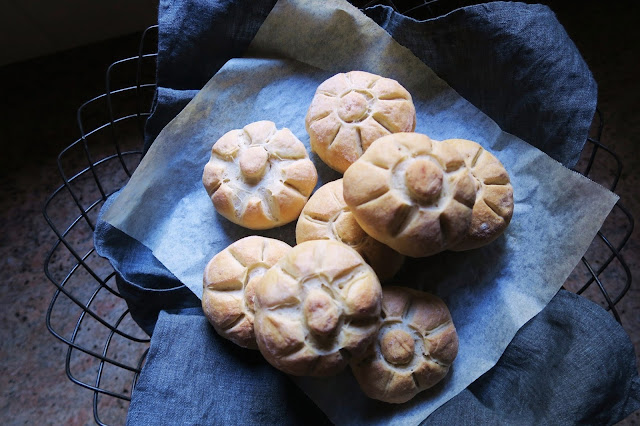
Sanguinaccio dolce is an Italian sweet blood pudding made from pig’s
blood, chocolate, nuts, dried fruits and spices. This is a historical recipe that dates back
to the time when pig’s blood was considered, due to its nutritional value,
almost sacred and deemed sacrilegious to waste even one drop. When my mother was growing up in the small
town of Montemurro in the Basilicata region of Italy, villagers slaughtered
their reared pigs to make sausages and other by-products during the 'pig
season'. Every part of the animal was
used, and this included the fresh collected blood to turn into this rich sweet
treat. This was a time of year when
family and friends gathered together to lend a helping hand and in return would
receive portions of the pig or later some of the preserved produce to settle a
debt or just simply to share around. It was very typical of country life, and
still occurs in some towns today; and as the saying goes, 'it takes a village
to eat a whole pig...' Nose to tail and everything within - offal, blood and
bones are used in the cooking and nothing is wasted.
In some
regions of Italy, sanguinaccio dolce
is associated with il Carnevale (carnival
holiday) that coincides with pig season, and prepared on the day before Ash
Wednesday - Martedi Grasso, also
known around the world as Fat Tuesday and Mardi` Gras. This Carnival holiday is
also celebrated in Montemurro every year and the celebrations take place in a
public parade around the streets of the town in which playful and imaginative
masked characters come to life. The
masks linked to this town’s Carnevale
relate to the 12 months of the year, where each person parading on horseback or
cart is dressed in costume and recites a rhyme representative of that month and
season. I was delighted to come across
some videos of Montemurro in the 1960’s while researching this topic and
surprised to spot my maternal grandparents amongst the crowd.
This short
video about Montemurro sums up the communal ritual of the pig festival. I must warn you though that the slaughtering
of the animal may appear barbaric and offensive to some. Once you have passed this scene, it moves
into the making of sausages, and then the Carnevale
festivities of the town.
I recall my grandmother telling us how she would help out and
receive some lard for the cooking or skin to make crackling as well as pigs’
blood to make sanguinaccio. Sometimes
this was considered payment for my grandfather's services, being the towns shoe
maker. Nonno Rocco appears in part 2 & 3 of these series of videos. Below are some photos that my uncle - zio
Filippo captured of nonno in his workshop and some of the locals of the town.
Sanguinaccio alla
maniera Lucana
Sanguinaccio dolce is a very rich sweet pudding with a
slight salty and metallic undertone that comes from the blood. Served warm, it resembles a thick hot
chocolate custard, and eaten with biscotti or savoiardi. With the addition
of nuts and dried fruits and allowed to set, it is like a traditional thick
pudding. Locals also use it as a filling
within a crostata (tart). I still recall its distinctive taste however
at the time I could not bring myself to eating more than a teaspoon full even
though mamma made it with lots of chocolate to disguise the idea of the main
ingredient. She would sometimes make a version of this pudding for us minus the
blood and substituted it with cornflour to thicken the chocolate.
Although many won't be attempting this
recipe, for the obvious reason that it requires fresh pig’s blood and since
1992 the sale of pig’s blood to the public has been banned, it is still worth
noting the process. In rural communities
where they rear and slaughter their pigs, the sanguinaccio making tradition still occurs. If you do manage to source some fresh blood
from a pig and are willing to try it out, the recipe below will assist you in
creating what many call a 'bloody' good desert.
Ingredients:
1 lt fresh pig’s blood
250 ml vin cotto
100 g grated dark chocolate or cocao
150 g honey
100 g raisins
150 g crushed walnuts or almonds
spices of choice 20 g each (cinnamon,
nutmeg, clove)
1 grated orange peel
Cook the filtered blood in a
terracotta pot over a gentle flame. Add
the chocolate, honey, vin cotto, and
other ingredients. Mix continuously with
a wooden spoon until all ingredients are combined and the mixture thickens.
When ready remove from the heat and place in serving bowls to set.
There are variations to this
recipe. Some use milk instead of the vin cotto while others also add a dash
of liqueur.
Follow
my previously posted Sweet Short Crust Pastry recipe
if you wish to use the sanguinaccio as a filling for a tart.
Below
are the links to the rest of the video clips:
I would like to thank my zio Filippo
for sending through these precious photos that he took of my grandfather and of
the township of Montemurro. (Voglio ringrazziare a zio Filippo che ci ha
mandato queste bellissime foto di nonno Rocco e del paese di Montemurro. Questi
ricordi sono preziosi)






Comments
Post a Comment